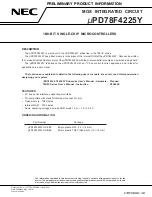
CHAPTER 3 CPU ARCHITECTURE
Preliminary User’s Manual U16315EJ1V0UD
54
3.1.4 Data memory addressing
Addressing refers to the method of specifying the address of the instruction to be executed next or the address of
the register or memory relevant to the execution of instructions. The address of the instruction to be executed next is
addressed by the program counter (PC) (for details, refer to
3.3 Instruction Address Addressing
).
Several addressing modes are provided for addressing the memory relevant to the execution of instructions for the
78K0/KD1 Series, based on operability and other considerations. For areas containing data memory in particular,
special addressing methods designed for the functions of special function registers (SFR) and general-purpose
registers are available for use. Data memory addressing is illustrated in Figures 3-6 to 3-10. For details of each
addressing mode, refer to
3.4 Operand Address Addressing
.
Figure 3-6. Data Memory Addressing (
µµµµ
PD780121)
Special function registers (SFR)
256
×
8 bits
Short direct
addressing
SFR addressing
Internal high-speed RAM
512
×
8 bits
General-purpose registers
32
×
8 bits
Reserved
Internal ROM
8192
×
8 bits
Register addressing
Direct addressing
Register indirect addressing
Based addressing
Based indexed addressing
H
0
0
0
0
H
F
F
F
1
H
0
0
0
2
H
F
F
C
F
H
0
0
D
F
H
F
D
E
F
H
0
E
E
F
H
F
F
E
F
H
0
0
F
F
H
F
F
F
F
H
F
1
E
F
H
0
2
E
F
H
F
1
F
F
H
0
2
F
F
















































